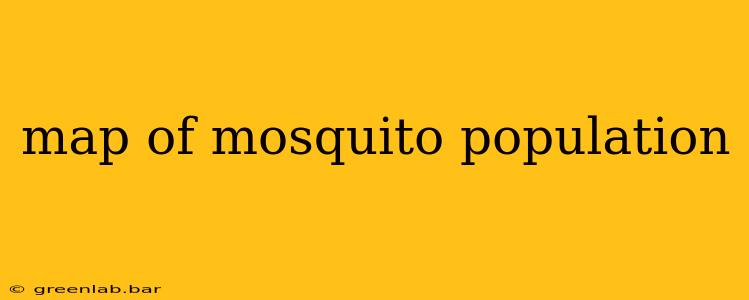Mosquitoes. The tiny insects that can cause significant global health problems. Understanding their population distribution is crucial for effective disease control and public health initiatives. While a single, universally accessible, real-time map of mosquito populations doesn't exist, several methods and resources provide valuable insights into their distribution and abundance. This article explores these approaches and highlights the complexities of accurately mapping this elusive, yet impactful, insect.
The Challenges of Mapping Mosquito Populations
Creating a precise, global map of mosquito populations faces several hurdles:
- Vast Species Diversity: There are over 3,500 mosquito species worldwide, each with unique habitats and breeding preferences. Mapping requires differentiating between these species, as their disease-carrying potential varies greatly.
- Dynamic Populations: Mosquito populations fluctuate dramatically based on environmental factors like rainfall, temperature, and the availability of breeding sites. A map accurate today might be outdated tomorrow.
- Data Collection Difficulties: Collecting mosquito population data is challenging. It requires extensive field surveys, trapping methods, and often relies on citizen science initiatives, which can lead to data inconsistencies.
- Accessibility and Data Sharing: Data collected by various organizations and researchers may not be readily available or easily integrated into a single, comprehensive map.
Existing Resources and Approaches
Despite the challenges, several approaches contribute to our understanding of mosquito distribution:
1. Surveillance and Monitoring Programs:
Many public health organizations and research institutions conduct active mosquito surveillance. These programs often involve:
- Trapping and Identification: Using various traps to capture mosquitoes, followed by species identification in laboratories.
- Larval Surveys: Inspecting potential breeding sites (standing water, containers) to assess larval abundance.
- Sentinel Surveillance: Monitoring mosquito populations in areas with high disease transmission risk.
The data gathered from these programs informs local and regional mosquito population assessments, though rarely compiled into a single, global map.
2. Climate and Environmental Data:
Mosquito distribution is heavily influenced by climate and environmental factors. GIS (Geographic Information Systems) technology leverages this data to create predictive models. These models estimate the likelihood of mosquito presence based on factors such as:
- Temperature: Mosquito development and activity are strongly linked to temperature.
- Rainfall: Abundant rainfall creates more breeding sites.
- Humidity: High humidity favors mosquito survival and reproduction.
- Vegetation: Certain vegetation types provide ideal resting and breeding habitats.
These models provide valuable insights, but predictions need validation with ground-truth data from surveillance programs.
3. Citizen Science Initiatives:
Citizen science projects, where members of the public contribute data, can supplement professional surveillance efforts. These initiatives often involve:
- Mosquito Reporting Apps: Users report mosquito sightings, providing valuable information on local abundance and distribution.
- Trap Deployment: Community members participate in setting and monitoring traps.
While citizen science data needs careful validation, it can significantly improve coverage, particularly in remote areas.
4. Remote Sensing Technologies:
Emerging technologies like satellite imagery and drones may contribute to future mosquito mapping efforts. These technologies can:
- Identify potential breeding sites: Detect standing water bodies from space.
- Monitor vegetation: Assess habitat suitability.
However, these methods are still under development and require further refinement for widespread application in mosquito population mapping.
The Future of Mosquito Population Mapping
Improving mosquito population maps requires collaborative efforts:
- Standardized Data Collection Protocols: Adopting consistent methods across different programs will enhance data comparability and integration.
- Advanced Data Analytics: Utilizing machine learning and other advanced analytical techniques to improve predictive models and extract insights from large datasets.
- Open Data Sharing: Promoting open access to mosquito surveillance data will accelerate scientific progress and resource development.
- Integration of Multiple Data Sources: Combining data from various sources (surveillance, environmental data, citizen science) will create more comprehensive and reliable maps.
While a complete, global map of mosquito populations remains a distant goal, ongoing research and technological advancements are steadily improving our understanding and ability to visualize the distribution of these disease vectors. This improved understanding is crucial in combating the spread of mosquito-borne illnesses globally.

